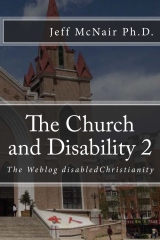Here is an excerpt from an article I am working on with my friend and
colleague, Bryan McKinney. This is an excerpt from the latest draft.
"When confronted with the possibility of certain types of
relationships, the social environment responds in a variety of ways. Let us consider a
continuum of responses from the environment then look at how human services
have been setting the tone for a significant understanding what disability is,
particularly as it relates to relationships. Society has responded in the
following ways.
1. Euthanasia
A 2016 article in the New York Post entitled,
“Europe’s ‘cure’ for autism is euthanasia” made the following statement,
In early childhood, the Dutch psychiatric patient
known as 2014-77 suffered neglect and abuse…He suffered terribly, doctors later
observed, from his inability to form
relationships…they treated 2014-77 for one more year, determined his case
was, indeed, hopeless and administered a fatal dose of drugs (emphasis added).
Doctors observed suffering due to an inability to
form relationships. It’s surprising that doctors evaluated interpersonal
relationships. Did they then work to facilitate the development of
relationships? The authors agree that the inability to form relationships could
lead to personal suffering. However, if people “suffer” from the inability to
form relationships, on whom can the blame be placed for that experience? If the
combination of your impairment leading to social skill deficits (difficult to
perhaps impossible to change) and my discriminatory eschewing of relationships
with you (potentially changeable via addressing someone’s attitudes), leads to
your being alone, shall we exclusively place the onus for change on you, the
person with the impairment, and when you cannot change, take your life? If
someone is suffering from social isolation to a significant degree because of
my attitudes, this should not be the response to their suffering.
2. Abortion
Weil (2006) observed, some parents choose not to
be in a loving relationship with a child with a particular characteristic,
specifically disability. There are those who chose to avoid such relationships
through prenatal diagnosis and abortion. As Rothman (1993) states, “decisions
to continue or terminate a pregnancy are never medical decision. They are
always social decisions” (p. 63). When faced with these “social decisions”,
“About
90
percent of pregnant women who are given a Down syndrome diagnosis have
chosen to have an
abortion” (Harmon, 2007). Reinders
(2000) relates that if a person is suffering from down syndrome, it is often
due to the way they are treated by society. So if they do suffer because of
society’s discriminatory treatment, our response as a society is to kill the
individual with down syndrome via abortion.
3. Segregation into institutions
The development of institutions for persons with
disabilities was initially based on the idea that they could be educated to the
point that they no longer experienced disability. Over time, it was realized
that persons in institutions largely did not improve appreciably and ended up
living a life of incarceration under inhuman conditions. However, for several
generations before the horrors of institutions came to light, doctors would
council parents of a newborn with severe disabilities, “Don’t hold or look at
the baby. It will be better for you both if she is placed in an institution. Interactions
had the potential to lead to relationships which might cause a family to not
place their child in an institution (Scheerenberger,1987). As has been stated,
“Social
skill deficits in persons with disabilities has arguably been the reason for
exclusion of persons with disabilities. But if the traditions of those without
disabilities leads to the exclusion of those with disabilities, then one must
wonder who has the social skill deficits?” (McNair & McKinney, 2015 p. 43)
4. Segregation into community residences
McKnight (1989) has written,
If one would say to the average citizen, “I want
you to take five men and buy a house in a neighborhood in a little town where
those five men can live for ten years. And then I want you to be sure that they
are unrelated in any significant way to their neighbors, that they will have no
friends, and that they will be involved in none of the associational or social
life of the town.” I think that almost every citizen would say that this is an
impossible task. Nonetheless…systems of…community services have managed to
achieve what most citizens would believe impossible-the isolation of labeled
people from community life even though they are embedded in a typical house in
a friendly neighborhood in an average town.
(McKnight,
1989, p. 2)
When the experience of life in an institution came
to light, people were shocked. They demanded that the institutions be closed.
As people were exited to community settings, the meager government financial
assistance caused them to live in places plagued by poverty. Arguably those
responsible were interested in protecting vulnerable individuals from the
community. As a result, the type of arrangements typified by McKnight’s
description above, were then and continue now to be pervasive. Persons in
community residential facilities have a difficult time forming relationships
with regular community members largely because they are being protected from
the community. Additionally, those vendored to provide such services fear
litigation should they allow access to the community and the community access
to the residents.
This has been the situation for decades and in
spite of concerns voiced about this arrangement, human services appear to be
satisfied with these arrangements simply because they continue and minimal
effort appears to have been made to alleviate fears of litigation should
residents be allowed access to the community.
5. Paid relationships
Human service agency personnel might be enlisted
to be in paid relationships with persons with disabilities. Baca and McNair
(2013) described the paid agents in these relationships as “almost friends.”
They also found severe problems with both agency understanding of friendship
and what was permitted, as well as what was or could be done in the development
of relationships, particularly friendships between people with disabilities and
community members. We will discuss this further, later in the paper.
6. Relationships with other clients
One might also facilitate relationships with other
persons with disabilities, particularly those under the care of state agencies.
Issues related to this are discussed by McMichael-Pierce (2015). She describes
how activities such as several group homes getting together for an activity or
two sheltered workshops participating in a party together are considered
community integration. These are evidence that state agency level and local
human service providers lack understanding about what community integration is
(that leads to integrated, unregulated social relationships).
7. Support families in relationship
It is arguable that there is an overreliance on
families to be the providers of social relationships for persons with
disabilities. Society, even within the church, appears to believe that persons
with disabilities are the responsibility of families almost exclusively.
Typical society members have bought into this perspective thinking if they pay
taxes, programs will be developed and they have no personal responsibility.
That this learned behavior is common is sad. That this same behavior exists
within the church in spite of Biblical passages about the church as a body (1
Corinthians 12) and our responsibility love our neighbor (Matthew 22:39 and
Mark 12:31) reflects the degree to which the church reflects patterns of the
world when it should not (Romans 12:2).
8. The development of programs
Related to number seven above, society inside and
outside of churches will choose to develop programs over engaging in
relationships. Instead of developing friendships with persons with disabilities
and their families, we develop programs to meet the needs that friendships
would typically meet. We see this, for example, in respite programs. When
families need a bit of a break, they will typically ask friends to watch their
child and then at another time return the favor. Respite programs are created
perhaps because families of children with disabilities do not have sufficient
relationships with friends who will watch their child. If there is a program,
it removes responsibility from me to develop a relationship which might make
demands on me. Respite programs may undermine the kinds of support that grows
out of or leads to friendship. Disability then is not addressed by
relationships. Disability is addressed with programs, even within churches.
Relationships remain unchosen in favor of programs which do not demand
relationships.
9. Social skill development
One might also work on social skill development in
an attempt to address impairments within individuals which could lead to difficulty
in social relationships (Snell & Brown, 2014). This might be considered a
medical model intervention (Silvers, Wasserman & Mahowald, 1998). The
success of this training might be evaluated on the degree to which persons with
disabilities are engaged in and chosen for integrated relationships.
10. Social ramps (universal design for social
environmental change) leading to inclusion has been described as an
intervention by McNair & McKinney (2015). The goal of this intervention is
to help social environments to do the right thing (Wolfensberger, 1998). This
might be considered a social model intervention (Oliver, 1990; Shakespeare,
2002).
11. Cultural change
Perhaps the ultimate way in which relationships
impaired or unchosen would be addressed is through cultural change. This
implies broadening what might be called typical in understanding relationships,
and seeking a cultural change in what would be chosen. From a Christian perspective
this would be no longer conforming to the patterns of the world (Romans 12:2).
The renewing of one’s mind which is also mentioned in this verse would be to
reflect a Biblical understanding of who people with disabilities are. This
understanding should lead to a cultural change in which they are seen as
created in the Image of God, having a purpose, being gifted and under the
sovereignty of God for themselves and for the larger body (McNair, 2015). This
perspective causes a change to chosen relationships and no relationships truly
being seen as impaired. This is not to say that difficulties faced by people
who have severe disabilities do not create relationships that cause significant
effort, it is just to say that people can learn to see these relationships as
desirable, beneficial, and depending upon one’s experience, even typical. The
result is that they change to being chosen relationships. The authors have
experience this change through efforts to be in relationship with persons with
severe disabilities."
This article is in preparation for the Journal of
the Christian Institute on Disability. Be looking for it, hopefully, in the
Fall 2016 issue of the journal.
McNair










